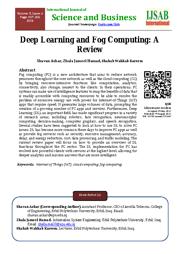A copy of this work was available on the public web and has been preserved in the Wayback Machine. The capture dates from 2021; you can also visit the original URL.
The file type is application/pdf.
Deep Learning and Fog Computing: A Review
2021
Zenodo
Fog computing (FC) is a new architecture that aims to reduce network pressures throughout the core network as well as the cloud computing (CC) by bringing resource-intensive functions like computation, analytics, connectivity, also storage, nearest to the clients. In their operations, FC systems can make use of intelligence features to reap the benefits of data that is readily accessible with computing resources to be able to resolve the problem of excessive energy use with power for
doi:10.5281/zenodo.5222646
fatcat:wevh4azi6za2hh74g2c66icaye

